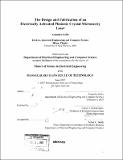| dc.contributor.advisor | Leslie A. Kolodziejski. | en_US |
| dc.contributor.author | Griñe, Alejandro (Alejandro Joaquin) | en_US |
| dc.contributor.other | Massachusetts Institute of Technology. Dept. of Electrical Engineering and Computer Science. | en_US |
| dc.date.accessioned | 2007-09-28T13:30:22Z | |
| dc.date.available | 2007-09-28T13:30:22Z | |
| dc.date.copyright | 2007 | en_US |
| dc.date.issued | 2007 | en_US |
| dc.identifier.uri | http://hdl.handle.net/1721.1/39001 | |
| dc.description | Thesis (S.M.)--Massachusetts Institute of Technology, Dept. of Electrical Engineering and Computer Science, 2007. | en_US |
| dc.description | Includes bibliographical references (p. 92-95). | en_US |
| dc.description.abstract | Spontaneous emission can be controlled by altering the environment that a medium radiates into; specifically, by reducing the dimensions of a cavity, excited atoms immersed in the cavity are more likely to spontaneously emit photons into the dominant cavity mode than spurious modes. Microcavity lasers exploit this stronger coupling by confining photons to a cavity with outer dimensions approximately the size of an optical wavelength. Owing to the strong coupling to the lasing mode, microcavity lasers are distinguished for their high efficiency, low threshold, high speed, and low noise operation. However, microcavity lasers by nature have low output power. Thus, microcavity lasers are ideal light sources for applications requiring low power such as integrated optics or quantum computation. This thesis describes the design and fabrication of a microcavity laser utilizing multiple photonic crystal mirrors. The laser is well suited for integrated optics for many reasons. It is electrically activated and emits light in-plane. The laser conserves chip real-estate and couples directly into an output waveguide. The one dimensional photonic crystal mirrors prevent coupling into radiation modes increasing the quality factor (Q) of the cavity. | en_US |
| dc.description.abstract | (cont.) Rate equation analysis is used to show that the laser will have a small threshold current. A new hybrid fabrication scheme is employed that simplifies the device processing. The step and repeat mask design makes it simple to fabricate and to test many devices each with varying dimensions, allowing one to empirically determine the optimal device. Finally, a new microcavity laser capable of confining light in three dimensions is proposed. | en_US |
| dc.description.statementofresponsibility | Alejandro Griñe. | en_US |
| dc.format.extent | 95 p. | en_US |
| dc.language.iso | eng | en_US |
| dc.publisher | Massachusetts Institute of Technology | en_US |
| dc.rights | M.I.T. theses are protected by copyright. They may be viewed from this source for any purpose, but reproduction or distribution in any format is prohibited without written permission. See provided URL for inquiries about permission. | en_US |
| dc.rights.uri | http://dspace.mit.edu/handle/1721.1/7582 | |
| dc.subject | Electrical Engineering and Computer Science. | en_US |
| dc.title | The design and fabrication of an electrically activated photonic crystal microcavity laser | en_US |
| dc.title.alternative | Electrically activated photonic crystal microcavity laser | en_US |
| dc.type | Thesis | en_US |
| dc.description.degree | S.M. | en_US |
| dc.contributor.department | Massachusetts Institute of Technology. Department of Electrical Engineering and Computer Science | |
| dc.identifier.oclc | 166539854 | en_US |
